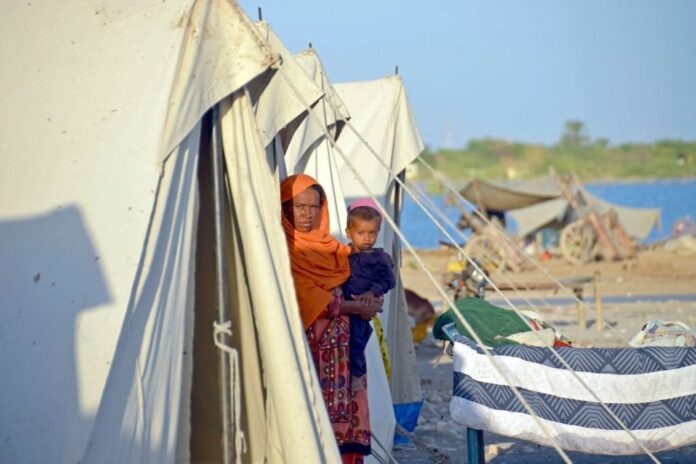GANDAKHA: Maryam Jamali should have been preparing for an economics exam. Instead, the teenager from the flood-hit province of Balochistan was helping organise postpartum clinics and shelter for people neglected by relief efforts.
Pakistan’s largest and poorest province is plagued by under-development, bad governance, corruption, and a long-running insurgency. When catastrophic floods submerged vast swaths of Pakistan this summer, about 75 percent of Balochistan’s population was affected, the largest proportion of any province in the country.
Yet recovery here has been slower, and residents say they are paying the price of years of neglect by the local and central government. Red tape is making it difficult for international aid workers to reach devastated areas.
Much of the already dilapidated pre-flood infrastructure has been washed away, further hampering aid efforts.
People still wade in waist-high water or float on rafts through Balochistan’s fields. On the pot-holed and suspension-shattering drive to Jamali’s village, there are deep ruts carved out by desperate locals to free trapped floodwaters. It is an uncomfortable car journey around the province’s flood-affected areas, though not so impossible or inaccessible as to be a reason for the slowness of aid.
It is a contrast to neighbouring Sindh, an agricultural, commercial, and manufacturing hub. At the height of the flooding, people in the Sindh city of Sukkur used boats on submerged roads. But pumps were brought in to remove water, and now there is little sign the city was ever flooded.
Balochistan was not so prepared, despite disaster striking it often. There was severe flooding in 2010 and 2011. The arid region normally has low rainfall, but any rain in this mountainous area can cause flash floods.
Jamali, her father, and dozens of volunteers have helped more than 20,000 flood survivors since mid-June.
“We haven’t seen any international organizations come here themselves,” said Jamali, 19. “Maybe they think this is a scary place. It’s not, it’s just a lack of effort on their part. It’s difficult to navigate through the bureaucracy. Because of all those hurdles they just didn’t come here this time.”
A drainage canal not far from her village illustrates what residents say is an infrastructure that protects Sindh at the expense of Balochistan.
Water from Balochistan’s Gandakha city is meant to be drained toward Sindh through the canal. But only one of the canal’s five gates are open. Cement seals the rest. Someone has written in Urdu “For God’s sake, open it up” on one of the canal’s walls. The floodwater was choking the city at one point, Jamali said.
Balochistan is not a political or economic heavyweight and doesn’t have a political patron like other provinces. Sindh is the power base of the Bhutto dynasty. Punjab is the home of a past and present prime minister and contributes the most to Pakistan’s GDP, and Khyber Pakhtunkhwa is a stronghold of former premier Imran Khan.
Though Pakistan’s largest province, Balochistan is its least populated, made up largely of high mountains. It’s also a centre for the country’s small ethnic Baloch minority, who say they face discrimination from the central government.
Local politician Sana Baloch claims the flood relief focus has been on Sindh and that there is a closed-door policy for Balochistan, unfairly using the insurgency as an excuse.
“International agencies and groups are willing to support people, but they are not welcomed by the federal government,” said Baloch. “They are not encouraged or allowed to come here.”
But there has also been criticism of local authorities for doing little even as the scale of the crisis grew.
In the Sohbatpur district, Muhammad Ismail is rebuilding his destroyed home while his family lives on the roadside.
“Nobody has come here to help us,” said Ismail, a 28-year-old father of five. “We ourselves drained the floodwater out – without any machinery – from this patch of land so we have somewhere to sit.”
An official from Balochistan’s disaster management authority, Naseer Nasir, said the central government had provided sufficient funds that were being distributed locally. He also said the authority had passed on people’s complaints to the provincial government.
The tents of Pakistani charities can be seen across flood-affected areas. Because of bureaucratic hurdles, foreign NGOs are partnering with local organizations, which don’t need permits for their work, said Huzaifa Rafique, from one Pakistani charity, Baitussalam.
Abdul Shakoor from another charity, Al-Khidmat, said it has hosted at least 90 different foreign delegations. He said some international NGOs are fearful of traveling to Balochistan because of security issues.
The province’s lack of social development only worsens the disaster’s impact. Poverty forces people to live on floodplains, while illiteracy prohibits them from adapting to the effects of climate change, said Rafique.
Although the province receives tens of millions of dollars for development work – the World Bank had a $250 million portfolio there as of 2019 — its human development indicators are dire. The maternal mortality rate is 298 per 100,000 live births, Pakistan’s highest. Its literacy rate is around 40 percent, and 40 percent of its population lives in poverty, both the worst rates in the country.
Patchy information about Balochistan, at the local, national, and international level, means accurate and up-to-date figures are scarce.
“The difference between an educated person and an illiterate person in everyday life is that he knows how to get help, he knows how to plug into the setup,” says Shakoor. “In the coming years, there should be a focus on educating Baloch children.”
The prospects for lasting rehabilitation are bleak; Jamali says one Gandakha resident has lived in a relief tent for 12 years, since the flooding of 2010.
“It’s not the same tent, it’s his second one, but he’s still in a tent,” she said.






















